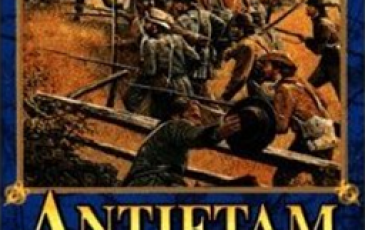27 May 62, Hanover Courthouse, Va - Battleground 5: Antietam

| Rating: | 0 (0) |
| Games Played: | 0 |
| SM: | 9 |
| Turns: | 10 |
| Type: | Custom |
| First Side: | Union |
| Second Side: | CSA |
| Downloads: | 29 |
27 May 1862, Hanover Courthouse, Va [Curt Cabbage]
The Army of the Potomac pushed slowly up the Pamunkey, establishing
supply bases at Eltham's Landing, Cumberland Landing, and White
House Landing. White House, the plantation of W.H.F. "Rooney"
Lee, son of General Robert E. Lee, became McClellan's base of
operations. Using the Richmond and York River Railroad, McClellan
could bring his heavy siege artillery to the outskirts of Richmond.
He moved slowly and deliberately, reacting to faulty intelligence
that led him to believe the Confederates outnumbered him significantly.
By the end of May, the army had built bridges across the Chickahominy
and was facing Richmond, straddling the river, with one third
of the Army south of the river, two thirds north. (This disposition,
which made it difficult for one part of the army to reinforce
the other quickly, would prove to be a significant problem in
the upcoming Battle of Seven Pines). While skirmishing occurred
all along the line between the armies, McClellan heard a rumor
from a Virginia civilian that a Confederate force of 17,000 was
moving to Hanover Court House, north of Mechanicsville. If this
were true, it would threaten the army's right flank and complicate
the arrival of McDowell's reinforcements. A Union cavalry reconnaissance
adjusted the estimate of the enemy strength to be 6,000, but
it was still cause for concern. McClellan ordered his close friend,
Maj. Gen. Fitz John Porter, commander of the newly formed V Corps,
to deal with the threat. Porter departed on his mission at 4
a.m. on May 27 with his 1st Division, under Brig. Gen. George
W. Morell, the 3rd Brigade of Brig. Gen. George Sykes's 2nd Division,
under Colonel Gouverneur K. Warren, and a composite brigade of
cavalry and artillery led by Brig. Gen. William H. Emory, altogether
about 12,000 men. The Confederate force, which actually numbered
about 4,000 men, was led by Col. Lawrence O'Bryan Branch, and
included the 7th, 18th, 28th, and 37th North Carolina Infantry
regiments, and the 45th Georgia Infantry. They had departed from
Gordonsville to guard the Virginia Central Railroad, taking up
position at Peake's Crossing, 4 miles (6.4 km) southwest of the
courthouse, near Slash Church. Another Confederate brigade was
stationed 10 miles (16 km) north at Hanover Junction. Porter's
men approached Peake's Crossing in a driving rain. At about noon
on May 27, his lead element, the 25th New York Infantry, encountered
Col. James H. Lane's 28th North Carolina on a reconnaissance
patrol at the farm owned by Dr. Thomas H. Kinney. The New Yorkers,
along with the 1st U.S. Sharpshooters, skirmished briskly with
the Confederates until Porter's main body arrived, driving the
outnumbered Rebels up the road in the direction of the courthouse.
Porter set out in pursuit with most of his force, leaving three
regiments (the 2nd Maine, the 44th New York, and the damaged
25th New York), under the command of Brig. Gen. John H. Martindale,
to guard the New Bridge and Hanover Court House Roads intersection,
a mile to the west of Kinney's farm. This movement exposed the
rear of Porter's command to attack by the bulk of Branch's force,
which Porter had mistakenly assumed was at Hanover Court House.
Branch also made a poor assumption—that Porter's force was significantly
smaller than it turned out to be—and attacked. Col. Charles C.
Lee led his own regiment, the 37th North Carolina, along with
the 18th North Carolina and two cannons from Latham's Battery.
An initial assault by the 18th was repulsed, but when the 37th
joined in, Martindale's force was almost destroyed by the heavy
fire. The 44th New York suffered 25% casualties and its battle
flag received 44 bullet holes. When messengers reached Porter
with news of the engagement, he quickly dispatched the 9th Massachusetts
and 62nd Pennsylvania regiments back to the Kinney Farm. The
Confederate line broke under the weight of thousands of new troops
and they retreated back through Peake's Crossing to Ashland.
The Army of the Potomac pushed slowly up the Pamunkey, establishing
supply bases at Eltham's Landing, Cumberland Landing, and White
House Landing. White House, the plantation of W.H.F. "Rooney"
Lee, son of General Robert E. Lee, became McClellan's base of
operations. Using the Richmond and York River Railroad, McClellan
could bring his heavy siege artillery to the outskirts of Richmond.
He moved slowly and deliberately, reacting to faulty intelligence
that led him to believe the Confederates outnumbered him significantly.
By the end of May, the army had built bridges across the Chickahominy
and was facing Richmond, straddling the river, with one third
of the Army south of the river, two thirds north. (This disposition,
which made it difficult for one part of the army to reinforce
the other quickly, would prove to be a significant problem in
the upcoming Battle of Seven Pines). While skirmishing occurred
all along the line between the armies, McClellan heard a rumor
from a Virginia civilian that a Confederate force of 17,000 was
moving to Hanover Court House, north of Mechanicsville. If this
were true, it would threaten the army's right flank and complicate
the arrival of McDowell's reinforcements. A Union cavalry reconnaissance
adjusted the estimate of the enemy strength to be 6,000, but
it was still cause for concern. McClellan ordered his close friend,
Maj. Gen. Fitz John Porter, commander of the newly formed V Corps,
to deal with the threat. Porter departed on his mission at 4
a.m. on May 27 with his 1st Division, under Brig. Gen. George
W. Morell, the 3rd Brigade of Brig. Gen. George Sykes's 2nd Division,
under Colonel Gouverneur K. Warren, and a composite brigade of
cavalry and artillery led by Brig. Gen. William H. Emory, altogether
about 12,000 men. The Confederate force, which actually numbered
about 4,000 men, was led by Col. Lawrence O'Bryan Branch, and
included the 7th, 18th, 28th, and 37th North Carolina Infantry
regiments, and the 45th Georgia Infantry. They had departed from
Gordonsville to guard the Virginia Central Railroad, taking up
position at Peake's Crossing, 4 miles (6.4 km) southwest of the
courthouse, near Slash Church. Another Confederate brigade was
stationed 10 miles (16 km) north at Hanover Junction. Porter's
men approached Peake's Crossing in a driving rain. At about noon
on May 27, his lead element, the 25th New York Infantry, encountered
Col. James H. Lane's 28th North Carolina on a reconnaissance
patrol at the farm owned by Dr. Thomas H. Kinney. The New Yorkers,
along with the 1st U.S. Sharpshooters, skirmished briskly with
the Confederates until Porter's main body arrived, driving the
outnumbered Rebels up the road in the direction of the courthouse.
Porter set out in pursuit with most of his force, leaving three
regiments (the 2nd Maine, the 44th New York, and the damaged
25th New York), under the command of Brig. Gen. John H. Martindale,
to guard the New Bridge and Hanover Court House Roads intersection,
a mile to the west of Kinney's farm. This movement exposed the
rear of Porter's command to attack by the bulk of Branch's force,
which Porter had mistakenly assumed was at Hanover Court House.
Branch also made a poor assumption—that Porter's force was significantly
smaller than it turned out to be—and attacked. Col. Charles C.
Lee led his own regiment, the 37th North Carolina, along with
the 18th North Carolina and two cannons from Latham's Battery.
An initial assault by the 18th was repulsed, but when the 37th
joined in, Martindale's force was almost destroyed by the heavy
fire. The 44th New York suffered 25% casualties and its battle
flag received 44 bullet holes. When messengers reached Porter
with news of the engagement, he quickly dispatched the 9th Massachusetts
and 62nd Pennsylvania regiments back to the Kinney Farm. The
Confederate line broke under the weight of thousands of new troops
and they retreated back through Peake's Crossing to Ashland.























